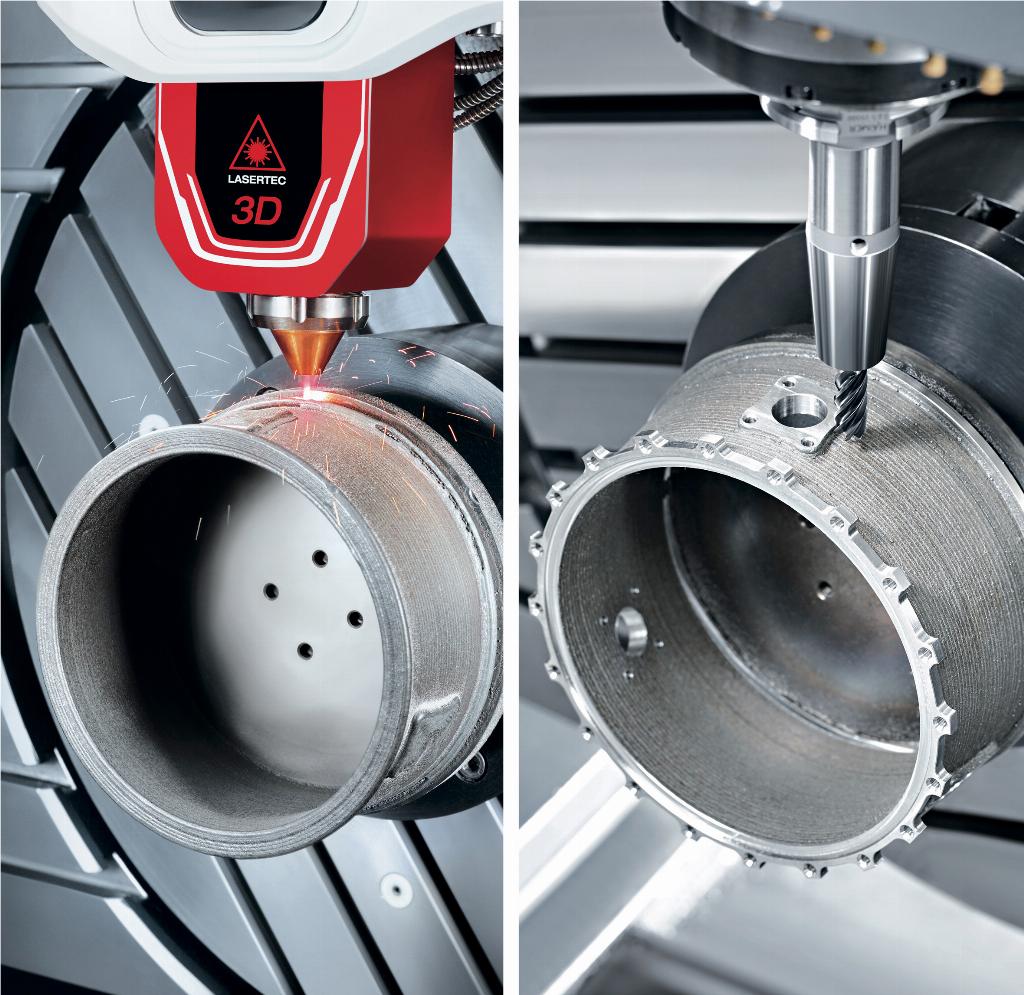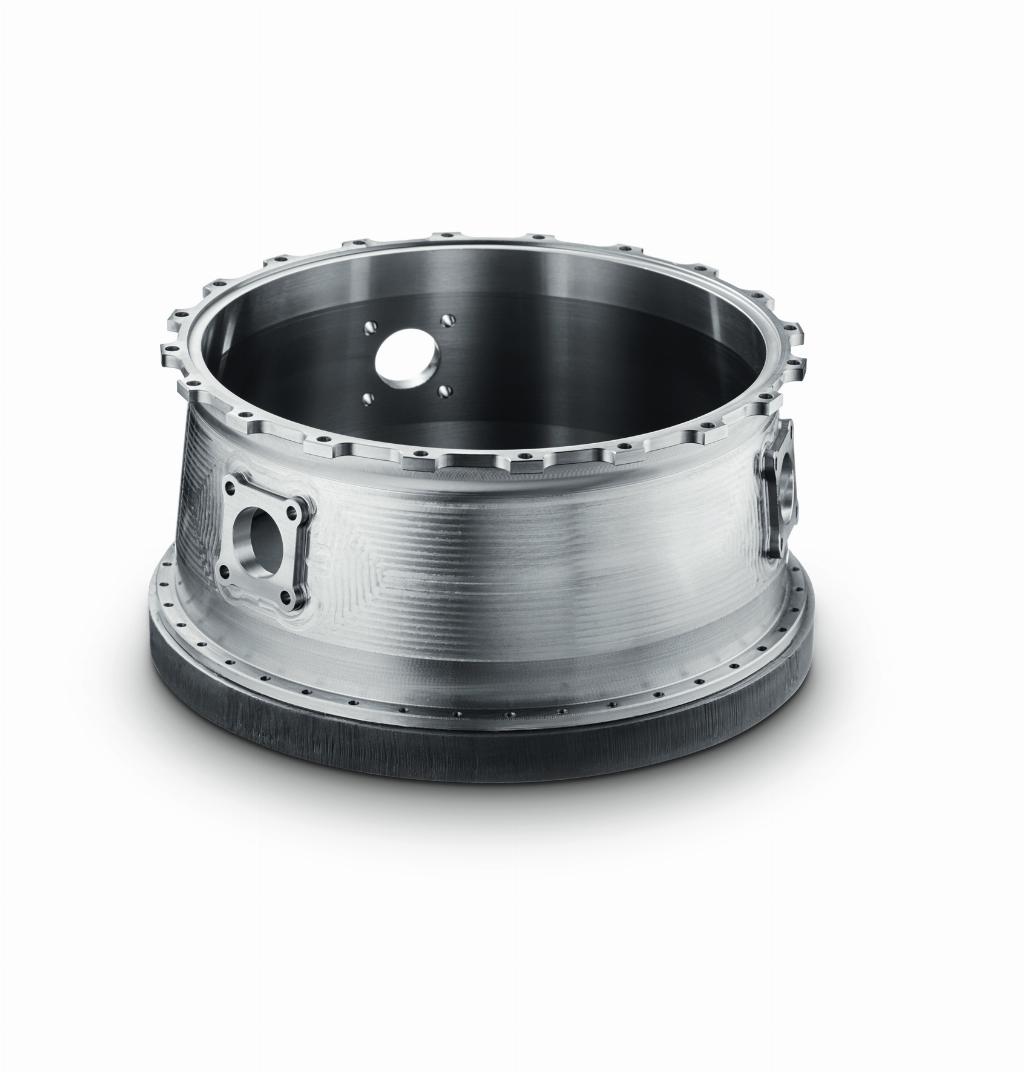It all adds up for complex parts

As a hybrid machine that incorporates laser deposition welding into a fully-fledged 5-axis milling machine, DMG Mori’s LASERTEC 65 3D enables the additive manufacture of complex aerospace components in finished part quality.
In times of decreasing product lifecycles and increasingly complex parts produced in ever smaller production runs, additive manufacturing processes can help companies produce new innovative products more quickly.
The aerospace industry has been using laser deposition welding in repair for many years, which makes it a very robust process. However, the unique combination of laser deposition welding, combined in a milling machine, gives the user completely new possibilities of application and geometries.
The LASERTEC 65 3D offers a hybrid solution for combined additive manufacture and 5-axis milling. This process for deposition uses a co-axial powder nozzle for the additive process. On larger components, the process can be over ten times faster than the generation using a powder bed machine.
The market for additive processes has grown rapidly in the past years. Up to now, these processes have been restricted to the production of prototypes and small complex parts. Such parts wouldn’t otherwise have been manufactured using conventional methods. For aerospace applications, particularly laser deposition welding can offer a quicker production of prototypes. The technology also gives more flexibility for manufacturing small batches and the opportunity of improving parts to product characteristics.

Additionally, with laser deposition welding it’s possible to alternate between two materials and selectively apply these materials to particular characteristics. This can prolong the life or reduce the cost of a component. The combination of metal deposition and metal removal on one machine complements each other. The new combination of processes enhances traditional machining methods.
To enable generative manufacturing, the LASERTEC 65 3D is equipped with a 2.5kW diode laser for laser deposition welding. On the same machine, the 5-axis milling capability, based on the robust monoBLOCK design, also makes it possible to undertake accurate milling operations.
“Thanks to the fully-automatic changeover between milling and laser operation, the LASERTEC 65 3D is suitable for the complete machining of complex components, even with undercuts,” explains Friedemann Lell, the sales director for the LASERTEC products at Sauer. “It can also be used for repair work, or the application of various hard or soft coatings. These applications could be used in a variety of industries ranging from mould making and aerospace to even medical engineering.”
Additive looms large
In contrast to laser melting in a powder bed, laser deposition welding enables large parts to be built using a metal powder nozzle. With a deposition rate of up to 1kg/h, this process is up to ten times faster than the laser generation of parts with a powder bed. The combination with milling opens up completely new possibilities. The component can be built up in several steps. The building process can be alternated with milling operations. Therefore, it is possible to build parts with features that are machined in the middle of the building process. These features would not normally be possible to reach afterwards with a milling cutter. This can give parts additional functionality, or enable the combination of more parts into a single module.
“In the case of structural components where today 95% of the material is removed by milling, with additive processes material is only built up where it is needed. This leads to significant savings in raw materials and costs,” explains Lell.
The complete laser additive head with powder deposition head and cooling is attached into the standard HSK toolholder of the milling spindle. The additive head can be automatically parked outside the working area in a secure station while milling operations are being undertaken in the working area of the machine. The machine and process are operated and controlled by means of the new DMG Mori CELOS operating panel, which is combined with the Siemens 840D solutionline Operate CNC control.
Production of 3D contours
Using a diode laser source to the metal powder is welded in layers onto a base. This base can be a component manufactured with traditional machining methods. The additive part is then literally ‘added’ on. The metal powder forms a high-strength welded bond with the base surface. The welding fuses the material without pores or cracks to form a 99.95% dense deposited material. The coaxial nozzle, which combines the laser beam and transports the powder with an inert gas, which at the same time prevents oxidation during the build-up process. After cooling, a layer of metal forms which can be machined mechanically.
Laser deposition welding has long been used as a repair method for demanding aero engine and gas turbine applications. It’s ideal for incorporation into DMG Mori’s high-quality CNC machines.
“The combination of chip-removal and additive processes will become more important in future as it opens up so many new possibilities for the user,” says Lell.

One strength of this process is the option to build up layers of materials in lines of either 1.6mm or 3mm width are possible, depending on the nozzle geometry. The machine can also be filled with two different materials. With a changeover that takes a few minutes, two different materials can be deposited after one another.
Another very important area of application is adding material to an existing part or body. This can be in order to customise, add functionality, features or react to product changes. The machine has the special capability to add material onto an existing 3D surface. Therefore, it is not always that a complete part has to be made, but adding value to something existing.
An economical solution
Large machines, such as those used for machining bulky components tend to be expensive. So the possibility of undertaking roughing, deposition and finishing on a single machine therefore represents a financially advantageous solution for the customer. Another example is the energy and oil industry where components often have to be coated with corrosion-resistant alloys to protect them against wear. Deposition welding provides protection for products such as pipes, fittings, flanges and special components that are used in aggressive environments. With a hybrid solution, machining of the base material, coating and finishing can be carried out on one machine. This results in cost savings and a reduction in floor-to-floor times.
During development of the LASERTEC 65 3D, DMG Mori has been looking at the complete manufacturing process chain. For customers, the finished product is important and not just the machine.
“The LASERTEC 65 3D can machine products more quickly when time is money,” Lell concludes. “It can also make better parts where quality counts. DMG Mori is revolutionising the complete process chain and not just the machines.”













